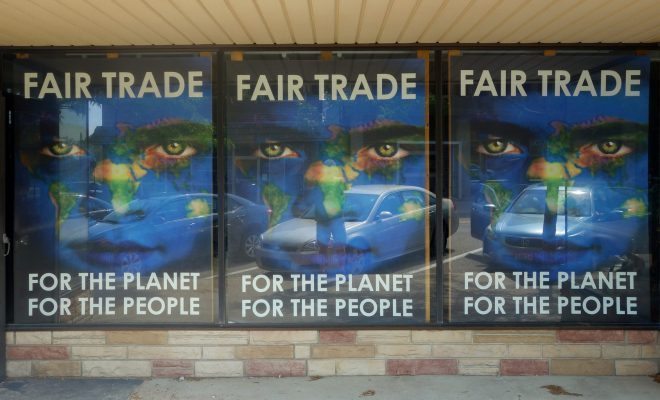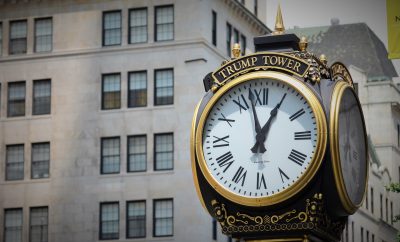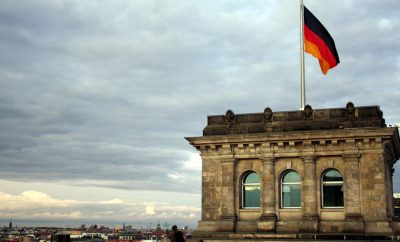 "Sustainability poster - Fair trade" courtesy of [Kevin Dooley via Flickr]
"Sustainability poster - Fair trade" courtesy of [Kevin Dooley via Flickr]
Business & Economics
The Costs (and Benefits) of Free Trade
There is not a lot that Donald Trump and Bernie Sanders agree on in their current presidential campaigns, but one thing the two do seem to share is a general disdain for free trade. The notion of free trade has joined the lexicon of despised things in the United States right next to bank bailouts and tax breaks for the rich. The clearest evidence of this is all the candidates’ desperate efforts to move as far away as quickly as possible from free trade agreements like NAFTA and the Trans-Pacific Partnership.
But is this much ado about nothing? Is free trade really gutting the economy and costing millions of jobs as suggested? More to the point, what does free trade mean? Read on to learn more about what free trade is and to find out if it is really as bad for Americans as some argue.
What is Free Trade?
Free trade does not mean that goods are given to other countries for free. It’s the idea that, for the sake of economic efficiency, tariffs, quotas, and trade barriers should be lowered or removed altogether, which economists argue will make goods cheaper for consumers. The process is aimed at improving efficiency by focusing on what is known as a country’s comparative advantage. Comparative advantage is the idea that a country should produce and export goods that it can make better, faster, and cheaper than other countries. By removing barriers to trade, two countries are left to compete with each other on their natural footing and whichever country can produce a good most efficiently has a comparative advantage for that good.
Comparative advantage is essential to free trade and is generally why economists like the concept of trade in general. Without barriers to trade, countries begin to specialize in products that they have a comparative advantage to produce, which ensures that all goods are made as efficiently as possible and lowering prices for everyone. The video below clarifies further what free trade is:
Globalization and Free Trade
Globalization and free trade are often seen as synonymous, but the two are not quite the same thing. According to the World Bank, “‘Globalization’ refers to the growing interdependence of countries resulting from the increasing integration of trade, finance, people, and ideas in one global marketplace.” Put simply, it’s the increasing inter-connectedness of every country and person on the planet.
Free trade, on the other hand, is a major driver in making globalization happen. By eliminating things such as tariffs and quotas, countries are encouraging exchange and, as a result, more people are coming into contact with each other and new connections are being made, further integrating the global system. Free trade, then, is just one part of the larger globalization puzzle.
History of Free Trade
Globally
While the constant battle over free trade seems to be an American issue, this is certainly not the case. While earlier theorists may have touched on its concepts, it was Adam Smith who first articulated the concept of free trade in his book “The Wealth of Nations” back in 1776. David Ricardo later introduced the concept of comparative advantage in 1812. The idea of free trade was rapidly adopted by economists after that as the preferred method of economic interaction. It was also embraced by the British Empire who, as the world’s dominant power for over a century, used its power to spread free trade internationally. Today, there are several free trade blocs across the world most notably the European Union as well as Canada, Mexico, and the United States, all of which are part of NAFTA, the North American Free Trade Agreement.
Domestically
Free trade, while not an America invention, does have a long history in the United States. However, for much of that history, the inclination was to resist it. In fact, from the inception of the United States, economic leaders such as Alexander Hamilton advocated for protective tariffs to help the nascent nation’s industry grow, instead of promoting free trade. This movement continued with the number of goods and the size of tariffs fluctuating over time.
Beginning in the early 20th century, a series of events played a major role in altering this narrative. In 1913 the United States government adopted the federal income tax, which became the country’s new largest source of income, supplanting the money made from trade tariffs. With the new guaranteed revenue stream, the government could change tariff rates without fear of forgoing necessary income.
The second major event was the passage of the Smoot-Hawley Tariff in 1930. This tariff was unique because it united industries like agriculture and manufacturing around one policy. It was also unique in the sheer amount of opposition that it faced. The debate following the tariff was whether it directly caused the Great Depression or just intensified it. While common wisdom now points to the latter, the tariff reduced trade and produced reactive tariffs from other nations during the worst period of economic contraction in U.S. history.
The tariff quickly became unpopular and was a major issue during the 1932 presidential campaign when Franklin Roosevelt ran on a platform opposing it. Once elected, Roosevelt made good on his promise, virtually eliminating the effects of the tariff by 1934 through a number of laws such as the Reciprocal Trade Agreements Act. Roosevelt and his advisors had their eyes on a post-war future in which free trade would be the dominant philosophy at last.
Following WWII, the United States finally adopted its free trade stance. The United States was under pressure to support free trade because many other nations were desperate following the war and wanted greater access to U.S. markets. This move was codified by the creation of the General Agreement on Tariffs and Trade (GATT) in 1948. This organization later transformed into its current iteration, the World Trade Organization (WTO) in 1995. While the United States did not embrace free trade for much of its history, it was already benefitting from the concept. This is because the United States was such a large market itself that trade between states was a lot like free trade enjoyed by countries in places like Europe.
Trade Agreements
NAFTA
NAFTA or the North American Free Trade Agreement is an agreement between Canada, Mexico, and the United States that took effect in 1994. Unlike other free trade agreements, this did more than eliminate tariffs and quotas, it effectively synced the policies of the three nations. It was also notable because of the economic differences between the three countries. NAFTA faced a lot of criticism because it sought to create uniform trade laws among the three countries involved. As a result, countries ended up changing their laws to meet the agreement’s requirements even if the same policies had been rejected at a local level in the past.
Namely, while treaties are supposed to require a two-thirds majority to pass in the Senate, according to the Treaty Clause, NAFTA received only a simple majority–more than 50 votes–and was still able to be signed into law. The question at hand was whether NAFTA was a treaty or an international agreement, which would not require a two-thirds majority in the Senate. As a result, NAFTA it was challenged in court but the case was eventually dismissed. The constitutionality of NAFTA was also challenged for its binational trading panels, which review the enforcement of U.S. trade laws and could even override such enforcement.
TPP
The TPP or Trans-Pacific Partnership is another free trade agreement like NAFTA but on a much larger scale. In this case, the deal includes 12 countries bordering the Pacific Ocean, notably excluding China. This deal again has many of the traditional criticisms and promises. Unlike NAFTA, however, the TPP has not yet been approved by Congress and may face significant opposition given the current backlash toward free trade.
Read more on the Trans-Pacific Partnership and its potential impact on intellectual property rights.
The accompanying video looks at free trade and free trade agreements following the switch in focus to free trade following WWII:
Criticisms of Free Trade
While free trade has been lauded in the past by economists, politicians, the media, and corporations, it has also drawn a lot of criticism. Most of these criticisms center specifically on its effects–namely that while free trade promises to be the rising tide that raises all boats, opponents claim that it actually does the opposite. First, by reducing tariffs and other protective measures a country is not only eliminating its own trade barriers but is doing the same thing for another country. If the two countries were operating on equal footing this would not be a problem, however, that is generally not the case.
In the case of a developed nation, like the United States, it has the economies of scale to put less efficient, smaller operations out of business. This is what happened in Mexico as large American agricultural companies started competing with small Mexican farmers, forcing them from their livelihoods and leading, in part, to their migration to the United States. Conversely, in countries where workers’ rights and environmental regulations are less developed these too can be exploited. In these countries, companies can lower the cost of production and undercut advanced nations with stronger regulations and higher standards.
In this sense then, the notion of comparative advantage is turned on its head. Instead of rewarding the best producer it can reward the cheapest or the least concise. This problem alone would be bad enough, but the critique continues. During this process of racing to the bottom, free trade has eliminated jobs in wealthier countries that pay more and created them in less advanced nations that pay less. Unfortunately, these newly employed workers are not wealthy enough to buy more goods and the now unemployed workers in the developed country are also buying less. According to critics, instead of creating a mutually beneficial society, free trade has brought about reductions in trade.
A major issue is that comparative advantage is supposed to move laborers from unproductive endeavors to more useful ones. But instead of seeing their efforts refocused in a more prosperous industry, workers in developed countries typically have to find jobs in different sectors of the economy. In countries like the United States, many factory workers have lost their jobs due to international competition. But instead of getting a different factory job they tend to move to the services industry, which typically involves lower wages.
There is some empirical support for these criticisms as well, with workers in the United States seeing a loss of manufacturing jobs since their height in the 1970s, rising trade deficits despite free trade, and low or negative wage growth. The question then is why would anyone support a concept that hurts the American worker while rewarding countries with loose regulations and low wages? The answer and the primary culprits in the criticism of free trade are the people who run multi-national corporations. According to the critics of free trade, the process naturally benefits these people as it allows companies to cut costs by paying its workers less while facing fewer regulations. The following video details some of the effects of free trade:
Despite all of its criticism and shortcomings, free trade is not all bad. The concept of competitive advantage increases the efficiency in the global economy. Aside from that, free trade offers a number of other potential benefits including reduced inflation, economic growth, greater innovation, increased competition, and greater fairness. Proponents of free trade also argue that turning to protectionism now won’t really solve the problem and may even be impossible. Finally, although manufacturing jobs have left the United States, many of those who gain jobs in other countries have been lifted out of extreme poverty.
Conclusion
Throughout U.S. history, Americans have grappled with whether protectionism or free trade is in their best interest. While free trade means more markets it also means greater competition, especially from places where things such as workers’ rights and environmental concerns are less prevalent. And it means doing away with protections that may very well have helped the nation develop and become a dominant world power.
However, trade policies, like anything else, move in waves. For the majority of the nation’s history, this wave has crested with protectionism on top. In fact, it took the greatest depression and largest war in the history to finally create a global system that favored free trade. While the Bretton Woods agreement and other deals such as NAFTA or TPP have continued, free trade policies have never been universally accepted. In an election where it seems like voters and candidates can hardly agree on anything across party lines, the current backlash against free trade may bring people together for at least a brief moment.
Resources
WBUR: Free Trade Fact-Check: NAFT Becomes Campaign Issue
Common Dreams: What’s The Problem With ‘Free Trade’
Foundation for Economic Education: Free Trade History and Perception
World Bank: Globalization and International Trade
CATO Institute: The Truth about Trade in History
The Fiscal Times: Free Trade vs. Protectionism: Why History Matters
The Economist: The Battle of Smoot-Hawley
BBC News: A century of free trade
Public Citizen: North American Free Trade Agreement (NAFTA)
BBC News: TPP: What is it and why does it matter?
Reference for Business: Free Trade Agreements and Trading Blocs
Law Street Media: What’s Going on With The Trans-Pacific Partnership
Los Angeles Times: Court Rejects Challenge to Constitutionality of NAFTA
Mercatus Center: The Benefits of Free Trade: Addressing Key Myths
“








Comments